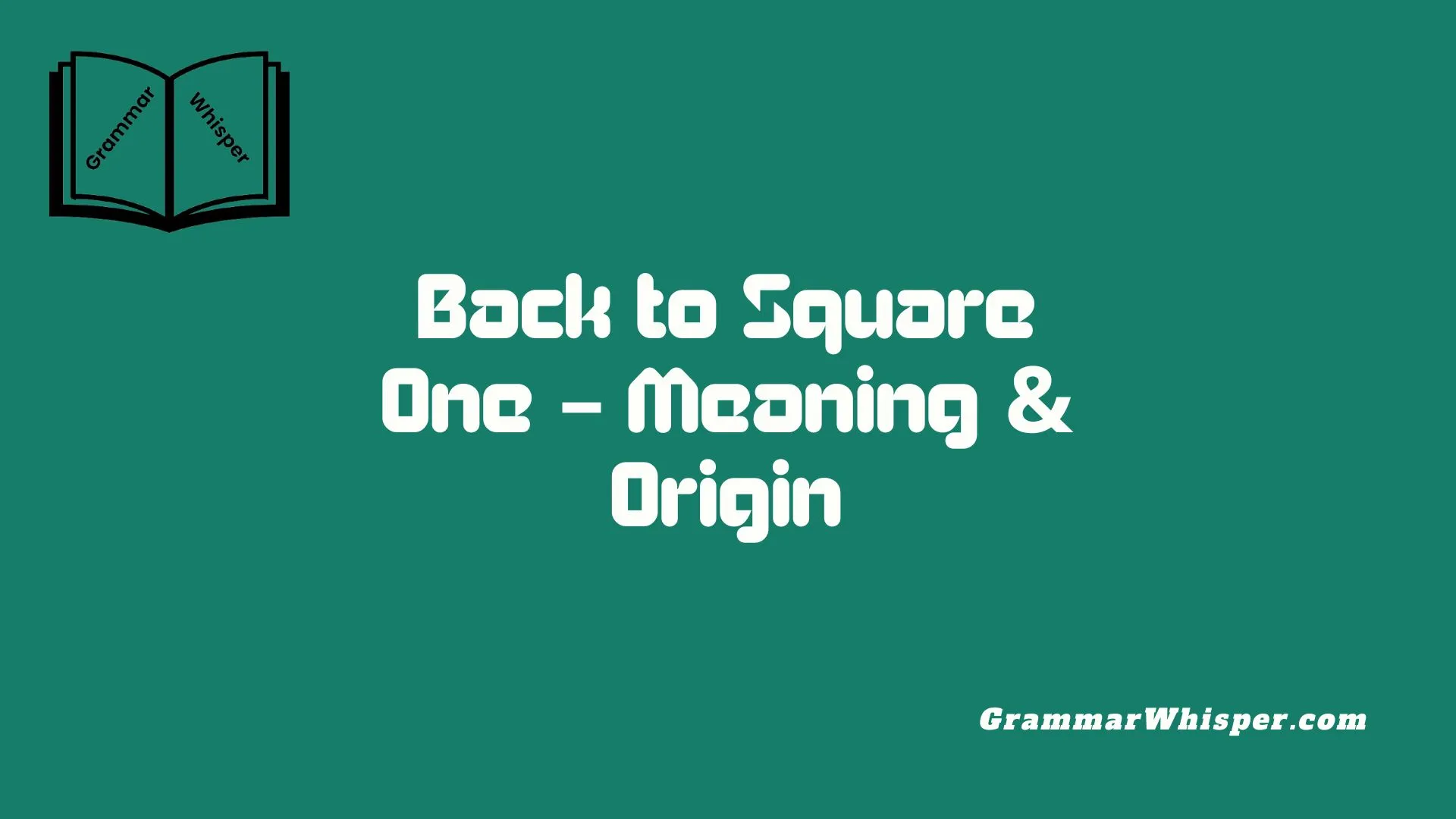The phrase “Back to square one” might seem like just an idiom, but it hits with emotional punch when you’re stuck and need to reset. In my own life, I’ve seen it unfold during career shifts, personal setbacks, and even broken relationships. What makes this phrase so powerful is the shift in mindset it demands. You’ve worked hard, made painful mistakes, adapted, and yet you find yourself where you began. That’s frustrating – but also full of opportunity.
I’ve come to realize that starting fresh isn’t failure; it’s part of the process. Sometimes, your original goals aren’t wrong – they’re just not quite ready yet. Whether it’s your work life or something more personal, going back allows you to rebuild with more insight. This idiom isn’t just about defeat – it’s about sharpening your aim, choosing better steps, and moving forward with fewer regrets. There’s power in those few words if you know how to use them.
What “Back to Square One” Really Means
Let’s break it down:
- Definition: You return to the beginning after plans fall apart or progress ends in failure.
- Everyday feel: Imagine baking a cake, burning it – and going back to scratch. That disappointment. That reset. That’s the idiom’s heart.
- Core connotations:
- A failure didn’t break you – you reset.
- A chance to learn and refocus.
- An opportunity to build smarter, not quit.
Using “Back to square one” in writing, speech, or thought brings in emotional depth – disappointment mixed with resilience. That contrast gives weight. Readers feel the setback, but also sense possibility.
Origins: Myths vs. Evidence
Where did this idiom come from? There are several theories rooted in British culture – and one leads the pack.
BBC Football Commentary
This is the most widely cited origin:
- Early BBC football commentators used “square one” to describe a pitch’s grid.
- When play reset (like a goalkick), the action returned to square one.
- Popular stories say this started in the 1920s–30s, during live radio broadcasts.
Evidence:
- Definitive printed records are scarce.
- Earliest appearances in BBC-related transcripts appear later, but commentators’ vivid style gave the idiom traction.
Snakes and Ladders / Hopscotch Theory
Another candidate:
- Board games with numbered squares might have influenced the phrase.
- Landing on the first square – or being sent back there – meant restarting.
But: No record of players calling it literally “square one.” It’s more a retro‑fitted connection than a documented origin.
Early 20th-Century Media Use
The phrase started appearing in newspapers and magazines:
- Usage spikes in the 1940s–50s in British print.
- Authors and journalists used it colloquially, hinting at its pre‑existing popularity.
Cultural and Global Interpretations
“Back to square one” isn’t just English‑language culture – it echoes worldwide. Let’s explore how different languages and cultures express the same idea.
Literal & Idiomatic Translations
| Language | Phrase | Meaning |
| French | revenir à la case départ | “Return to start square” |
| German | wieder von vorne anfangen | “Begin again from the front” |
| Spanish | volver a empezar desde cero | “Start again from zero” |
| Japanese | 振り出しに戻る (furidashi ni modoru) | “Return to the starting point” |
Despite idioms being language‑specific, these versions mirror the same sentiment: restarting after a setback.
Cultural Contexts Across Regions
- East Asian cultures (Japan, China) frame resets as a norm in practice-based activities (arts, martial traditions).
- Western cultures often tie the phrase to hustle, business pivots, and second chances.
- Indigenous languages sometimes describe spiritual rebirth or circle-of-life restarts, echoing the same psychological landscape.
Everyday Narratives: Back to Square One Moments
Let’s see this idiom in real life – how it plays out from boardrooms to bedrooms.
Simplicity of Use
Examples when people say it:
- Business “Our launch failed – we’re back to square one on strategy.”
- Education “I changed majors three times – felt like I kept going back to square one.”
- Relationships “After the breakup, rebuilding trust meant I went back to square one.”
- Personal growth “Quitting smoking? I keep going back to square one every time.”
Wake‑up moment: failure isn’t final. It’s a soft launch for round two.
The Psychology of Starting Over
Most people fear resets – they feel like failure. But “Back to square one” is more nuanced:
- Emotional impact:
- Frustration, disappointment, embarrassment.
- But also clarity: a reset often gives sharper focus.
- Mindset matters:
- Defeatist mindset: “I’m failing” → giving up.
- Growth mindset: “I’m learning” → restarting smart.
- Advice from experts:
- Carol Dweck’s work on growth mindset emphasizes failure as fuel for refinement and resilience.
In Business & Leadership
This idiom becomes a strategy in professional life – when projects deviate, sometimes a full reset works best.
Iteration in Tech & Startups
- Lean startups embrace pivoting early – if a product misses, they go “back to square one” and iterate.
- Agile development resets sprints based on feedback – permanent improvement.
Case Studies
Steve Jobs – Apple (1985–1997)
- Forced out of Apple, returned to start, rebuilt with focus on simplicity and design-led products (iMac, iPod).
Sir James Dyson – Inventor
- After 5,126 failed vacuum prototypes, he restarted multiple designs before the bagless cyclone became a global hit.
“Failure is actually the best teaching tool I know.” – James Dyson
Linguistic Depth & Why It Endures
What makes this phrase stick around?
- Memorable structure: short words, a strong metaphor.
- Rhetorical balance: “square one” evokes visuals of maps, games, resets.
- Related idioms: share its power –
- “Start from scratch”
- “Clean slate”
- “From zero”
The associative web of related terms enhances its presence.
Summary Table for Quick Reference
| Element | Insight |
| Definition | Resetting to start after a setback |
| Origin theories | BBC broadcasts, board games, print sources |
| Cultural translations | Globally present, same sentiment |
| Everyday usage | Business, school, relationships, habits |
| Psychology | Frustration + growth mindset = positive resets |
| Business relevance | A key tactic in tech, entrepreneurship, design |
Final Thoughts
Starting over can feel like defeat – but it doesn’t have to be. The phrase “back to square one” reminds us that progress isn’t always linear. Sometimes, the smartest thing you can do is stop, reevaluate, and return to the beginning with more experience, better tools, and a clearer direction.
This idiom endures because it’s more than just a catchy saying. It taps into something universal – resilience. Whether you’re an entrepreneur pivoting a failed startup, a student switching majors, or someone rebuilding a personal relationship, going back to square one is often the moment your next big success begins.
Instead of fearing the reset, learn to embrace it. As the Japanese proverb goes, “Fall down seven times, stand up eight.” That’s the real power of square one – it’s not a punishment, it’s a platform.
FAQs
What is the origin of “Back to Square One”?
The phrase likely originated from BBC football commentary in the early 20th century, where commentators used a numbered grid system to describe field positions. “Square one” referred to the start of play. Other theories suggest links to board games like Snakes and Ladders, but no single origin is confirmed. The idiom entered mainstream use in British media by the 1940s.
Is “Back to Square One” a negative expression?
Not necessarily. While it implies a setback, it doesn’t carry permanent negativity. Many use it to describe the opportunity to start fresh, often after gaining experience or clarity. In fact, in business, personal growth, and creative projects, going back to square one is often viewed as strategic and even empowering.
Can “Back to Square One” be used in formal writing?
Yes, it can – but use it thoughtfully. In professional contexts like reports, speeches, or essays, it’s appropriate when illustrating the idea of restarting a process due to failure, error, or reconsideration. If you’re writing in a strictly academic tone, consider more formal alternatives like “returning to the initial phase” or “restarting the process.”
What are some synonyms or alternatives for “Back to Square One”?
Here are a few commonly used synonyms:
- Start from scratch
- Clean slate
- Start over
- Go back to the beginning
- Reboot
- Reset the clock
Each of these carries a slightly different tone, so choose based on the emotional and contextual weight you want.
How can I avoid going back to square one in my projects?
Good planning helps, but even the best plans sometimes fall apart. Here are some practical tips:
- Test early and often – especially in tech and design.
- Document your process so restarts aren’t blind.
- Reflect frequently to catch small issues before they become big ones.
- Stay flexible – the ability to pivot prevents total resets.
- View setbacks as learning opportunities, not failures.
Remember: going back to square one isn’t a sign of failure – it’s a chance to build something better.











